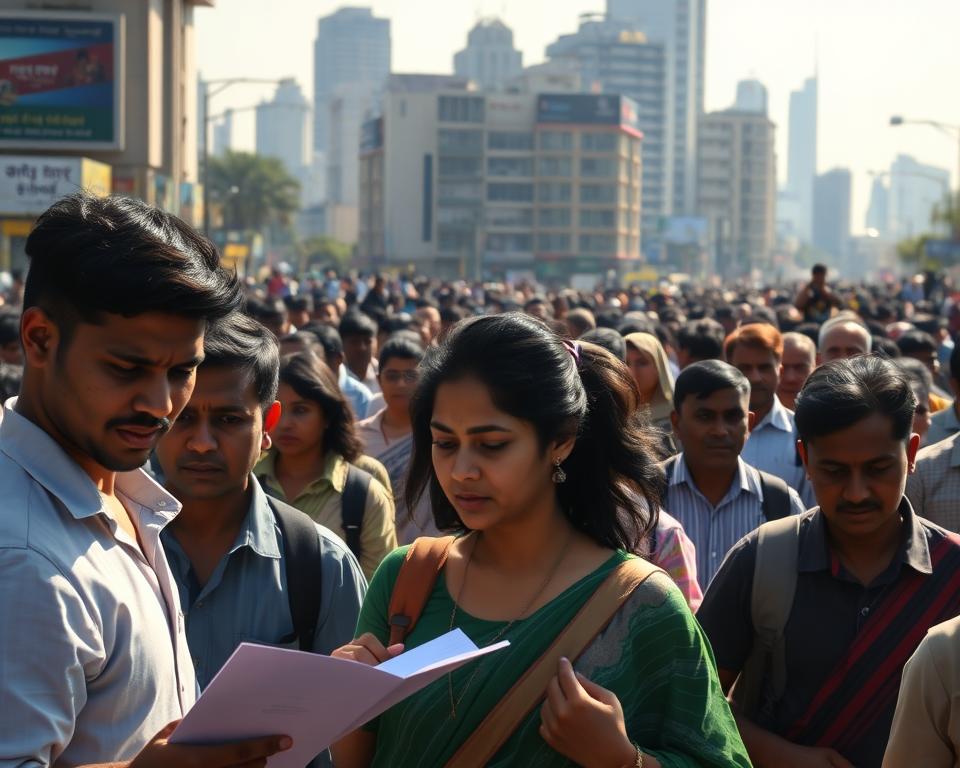The job market in India is changing fast. This brings many challenges for Indian job seekers trying to find work.
People often find it hard to get a job. This is because their skills don’t match what employers want. Also, not having enough experience is a big problem.
We need to find ways to help job seekers in India do better.
Key Takeaways
- Understanding the current job market in India is vital.
- Identifying key employment challenges can help in devising effective strategies.
- Enhancing skills and gaining relevant experience are key to success.
- Job seekers must adapt to the changing job market.
- It’s important to know what employers expect.
The Current Job Market Landscape in India
The job market in India is always changing. It’s shaped by many things like the economy, industry trends, and who’s working. These factors mix together in a complex way.

Key Statistics and Employment Trends
Recent employment statistics show a mixed picture. The IT and services sectors are growing. But, manufacturing and agriculture are facing problems. Many graduates are looking for jobs every year.
Supply-Demand Imbalance Across Sectors
A big issue is the supply-demand imbalance. Fields like data science and AI need more skilled people. But, there aren’t enough. On the other hand, many graduates in old fields can’t find jobs because they lack the right skills.
Impact of Economic Factors on Hiring
Economic factors greatly affect who gets hired. Things like GDP growth, inflation, and government policies matter a lot. For example, when the economy slows down, companies hire less. But, policies that help certain industries can create new jobs.
Educational System Gaps and Employment Readiness
India’s education system is facing a big problem. It’s hard to mix book learning with the skills needed for jobs. This makes it tough for graduates to find work.
Theoretical vs Practical Knowledge Divide
The Indian education system mainly focuses on book learning. This means students often lack the practical skills employers want. For example, engineering students might know a lot of theory but not how to apply it in real life.

Curriculum Relevance to Industry Requirements
Many schools in India don’t teach what employers need. This disconnect means graduates don’t have the right skills. Making the curriculum more up-to-date and involving industry experts can help.
University-Industry Collaboration Shortfalls
Working together between schools and businesses is key. But in India, this partnership is often weak. This gap in skills is a big problem. Better partnerships can help graduates get jobs.
Case Studies of Successful Educational Models
Some schools in India are doing things right. They mix book learning with practical skills. For example, some engineering colleges work with companies to give students real-world experience. These success stories can inspire other schools.
- Implementation of project-based learning
- Industry-sponsored research projects
- Internship programs with leading companies
By using new methods, schools can make their graduates more job-ready.
The Skills Gap: What Employers Want vs What Candidates Offer
India’s job market is changing fast. There’s a big gap between what employers need and what job seekers can offer. This gap is not just about a lack of skilled workers. It’s also about the mismatch between school teachings and what the industry needs.
Technical Skills Deficiencies in High-Demand Fields
Fields like data science, AI, and cybersecurity need more technical skills. But many candidates don’t have the right skills. For example, knowing programming languages like Python, Java, and C++ is key. Yet, many graduates aren’t well-trained in these areas.
Critical Soft Skills Shortcomings
Soft skills like communication, teamwork, and problem-solving are vital today. But many Indian job seekers find it hard. This is often because traditional education doesn’t focus enough on these skills.
Emerging Skills Requirements in the Digital Economy
The digital economy is changing what skills are needed. New tech like blockchain, IoT, and cloud computing is becoming more important. Candidates who can learn these new technologies are more likely to succeed.
Industry-Specific Competency Expectations
Each industry has its own needs. For example, finance needs people who know about financial rules and risk. IT needs those who know the latest tech. Knowing these specific needs is key for job seekers to stand out.
To close the skills gap, we need to do many things. We must update school curricula, support ongoing learning, and work together with industries. By tackling these issues, Indian job seekers can meet employer needs better. This will help them in the competitive job market.
Resume and Application Pitfalls
Many Indian job seekers face challenges with their resumes. A well-made CV is key but often ignored. This leads to missed chances.
Common CV Mistakes Among Indian Applicants
Indian applicants often make big mistakes on their CVs. These include:
- Including irrelevant personal details
- Using a generic CV for all job applications
- Failing to quantify achievements
- Typos and grammatical errors
A LinkedIn survey found 58% of recruiters reject CVs with typos or errors. It’s vital to have a perfect, job-specific CV.
Application Customisation Issues
It’s important to customise your CV and cover letter for each job. But many don’t, leading to being ignored.
“The right message, delivered to the right person, at the right time, can make all the difference.”
A customised application shows you’re interested in the job. It also highlights your relevant skills.
| Customisation Aspect | Generic Application | Tailored Application |
|---|---|---|
| CV Content | General information | Job-specific skills and achievements |
| Cover Letter | Standard greeting and content | Personalised greeting and job-relevant content |
Digital Footprint Management
Managing your digital footprint is key. Employers often check online before hiring.
To manage your digital footprint well:
- Keep your LinkedIn profile professional and current
- Remove unprofessional content from public social media
- Make professional content to show your skills
ATS Optimisation Strategies
Many companies use Applicant Tracking Systems (ATS) to filter applications. To make your CV ATS-friendly:
- Use keywords from the job description
- Keep a clear and standard format
- Avoid images and tables unless needed
By tackling these common pitfalls, Indian job seekers can boost their job market success.
Interview Performance Challenges
Indian job seekers often face big hurdles in interviews. This can stop them from getting a job. Interviews are key to show off skills and fit for the role. But, many challenges can get in the way.
Communication and Language Barriers
Good communication is vital in interviews. But, language barriers can make it hard to speak clearly. Accent and pronunciation issues can cause misunderstandings. A small vocabulary can stop a candidate from sharing their thoughts and experiences.
- Difficulty in articulating thoughts due to language limitations
- Misunderstandings caused by accent and pronunciation differences
- Lack of confidence in using English or other required languages
Preparation Inadequacies and Knowledge Gaps
Being well-prepared is essential for a good interview. But, many Indian job seekers lack knowledge of the company or the role. This can lead to poor answers to common questions and show they don’t fit the job.
Cultural Fit Assessment Hurdles
Cultural fit is key in the hiring process. It shows how well a candidate fits into the company’s culture. Indian job seekers may struggle with cultural differences, mainly in multinational companies or industries with unique cultures.
Virtual Interview Adaptation Issues
Virtual interviews are becoming more common. But, they bring new challenges like technical issues and adapting to a different interview format. Candidates must learn to use virtual platforms and look professional online.
To beat these challenges, Indian job seekers need to work on their communication, prepare well for interviews, and understand employer cultures. By improving these areas, candidates can do better in interviews and get more job opportunities.
Regional and Cultural Factors Affecting Employment
It’s key to know how regional and cultural factors shape India’s job scene. The country’s varied cultures and regional gaps pose big challenges for those looking for work.
Geographic Disparities in Job Opportunities
Jobs in India differ a lot by region. Cities like Mumbai, Delhi, and Bangalore have lots of tech jobs. But, rural areas face fewer job chances and less infrastructure.
| Region | Major Industries | Job Opportunities |
|---|---|---|
| Metropolitan Cities | IT, Finance, Marketing | High |
| Rural Areas | Agriculture, Small-scale Industries | Limited |
Language and Dialect Considerations
Language is very important in India’s job world. English is common in offices, but local languages matter too. Knowing many languages can help you stand out, mainly in roles where you talk to customers.
Language skills can be a key differentiator in the job market.
Cultural Expectations in Different Corporate Settings
Cultural norms change in each workplace in India. It’s important for job seekers to understand these differences to fit in and do well.
Navigating Diversity and Inclusion Challenges
Workplaces in India are focusing more on diversity and inclusion. Job seekers should be ready to work in diverse settings and show they can do it.
Key strategies for navigating diversity and inclusion challenges include:
- Being sensitive to cultural differences
- Demonstrating inclusive behavior
- Participating in diversity and inclusion initiatives
Why Indian Job Seekers Struggle to Get Hired (and How to Fix It)
The hiring process in India is tough for job seekers. This is due to both big problems and personal issues. Knowing these problems is key to finding solutions.
Systemic Barriers in the Hiring Ecosystem
The Indian hiring world has big problems. There’s a gap between what schools teach and what jobs need. Also, there’s not enough training to help people grow.
Key systemic barriers include:
- Limited industry-academia collaboration
- Insufficient focus on practical skills development
- Biases in the hiring process
Individual Preparation and Presentation Limitations
Job seekers also face personal challenges. Many lack important soft skills like talking well and working in teams. Employers really value these skills.
To overcome these limitations, job seekers can:
- Enhance their technical skills through online courses and certifications
- Develop soft skills through workshops and training programs
- Improve their resume and online profiles to better showcase their abilities
Bridging Expectation Gaps Between Employers and Candidates
A big problem is the gap in what employers and job seekers expect. Employers want specific skills and experience. Job seekers often have different ideas about jobs and pay.
| Expectation Gaps | Employer’s Expectation | Job Seeker’s Expectation |
|---|---|---|
| Skills | Specific technical skills | Opportunities for skill development |
| Experience | Relevant industry experience | Career growth and stability |
| Compensation | Market-standard salary | Higher salary for skills and experience |
Success Stories and Transformation Examples
There are many success stories. Job seekers have overcome challenges with hard work and learning new skills. For example, those who learned in-demand skills online have found better jobs.
By tackling big problems, improving personal skills, and meeting employer expectations, Indian job seekers can do better. The right approach and support can lead to success.
Building a Competitive Skill Set for Today’s Market
The modern Indian job market needs a mix of technical and soft skills. The economy is changing fast. This means more jobs for people who can use new tech and work in different places.
Industry-Relevant Technical Skills Acquisition
Getting the right technical skills is key for job hunters. It’s important to keep up with new tech and trends in your field. For example, skills in data science, AI, and cloud computing are in high demand.
Key areas for technical skills acquisition include:
- Programming languages such as Python, Java, and C++
- Data analysis and visualisation tools
- Cloud computing platforms like AWS and Azure
- Cybersecurity measures and protocols
Essential Soft Skills Development Strategies
Technical skills are important, but soft skills matter too. Skills like communication, teamwork, and problem-solving are key. These skills make you more employable.
Effective strategies for soft skills development:
- Join team projects and work together
- Practice public speaking and presentations
- Listen to feedback and learn from it
- Go to workshops and seminars on soft skills
Continuous Learning and Upskilling Approaches
The job market changes fast. You need to keep learning and getting better at your job. Being open to new skills and adapting to new demands is important.
Certification and Credential Optimisation
Getting the right certifications can really help your career. Choose ones that employers value and recognise.
| Certification | Field | Benefits |
|---|---|---|
| AWS Certified Developer | Cloud Computing | More job chances, better pay |
| Certified Data Scientist | Data Science | More trust, better job options |
| Certified Scrum Master | Agile Project Management | Better project skills, more demand |
By focusing on technical, soft skills, and learning, Indian job seekers can stay ahead. This way, they meet the needs of today’s job market.
Crafting an Impactful Resume and Digital Presence
The Indian job market is getting tougher. A well-made resume and a strong online presence are key. We’ll look at how to make a standout resume, boost your LinkedIn profile, and build a personal brand that employers will notice.
Resume Optimisation Techniques for Indian Job Market
To make your resume stand out in India, tailor it to each job you apply for. Highlight the skills and experiences that match the job. Using job keywords can help your resume pass ATS checks and grab the attention of hiring managers.
Key Resume Optimisation Techniques:
- Use a clear, concise format
- Highlight achievements over responsibilities
- Include relevant keywords
- Quantify your achievements
LinkedIn Profile Enhancement Strategies
A good LinkedIn profile is vital for your digital image. Start with a professional photo and a headline that clearly states your professional brand.
Effective LinkedIn Strategies:
- Regularly update your profile with fresh content
- Engage with others’ posts and share relevant content
- Request recommendations from previous colleagues and managers
Portfolio Development for Different Industries
A portfolio that shows off your work can boost your job chances. The kind of portfolio you need depends on your field.
| Industry | Portfolio Tips |
|---|---|
| Writing and Content Creation | Include a variety of writing samples, articles, and blog posts. |
| Design and Visual Arts | Showcase your best design work, including graphics, logos, and other visual elements. |
| Software Development | Share code snippets, projects on GitHub, and any other relevant coding work. |
Personal Branding in a Competitive Environment
Personal branding means showing what makes you special in the job market. It’s about knowing your strengths, values, and what makes you different.
Personal Branding Tips:
- Define your unique value proposition
- Consistently communicate your brand across all platforms
- Engage in thought leadership by sharing your insights and expertise
Mastering the Job Search Process
To stand out in India’s crowded job market, job seekers must adopt a targeted approach. This means understanding the job market, finding the right opportunities, and showing employers why you’re a good fit.
Targeted Job Search Strategies
A targeted job search starts with knowing your strengths and career goals. Research industries and companies that match your goals. Use industry reports and company websites for insights.
Job search platforms and company career pages are also useful. Tailor your resume and cover letter for each job. Highlight the skills and experiences that match the job.
Effective Networking in the Indian Context
Networking is key in India’s job market. Personal connections can lead to job opportunities. Attend industry events, conferences, and job fairs to meet professionals.
Use social media, like LinkedIn, to build your network. Engage with industry content, join online discussions, and ask for advice or informational interviews. This can expand your network.
Leveraging Job Portals and Recruitment Agencies
Job portals and recruitment agencies are great resources. Popular job portals in India, like Naukri.com and indeed, list many job openings. Recruitment agencies specialise in matching candidates with jobs.
Register with reputable agencies and keep your profile updated. They can offer insights into the job market and required skills.
Hidden Job Market Access Techniques
To access the hidden job market, be proactive. Use your network to find unadvertised job openings. Ask contacts about job openings or referrals.
Directly approach companies you’re interested in, even if they’re not advertising jobs. This shows initiative and can lead to job offers or internships.
| Job Search Strategy | Description | Benefits |
|---|---|---|
| Targeted Job Search | Focusing on specific industries and companies that match one’s skills and interests. | Increases the likelihood of finding a relevant job opening. |
| Networking | Building professional relationships through events, social media, and direct outreach. | Can lead to job opportunities not advertised publicly. |
| Job Portals and Agencies | Utilising online job portals and recruitment agencies to find job openings. | Provides access to a wide range of job listings and expert advice. |
Interview Preparation and Performance Enhancement
Getting ready for an interview is key to impressing employers. It’s about researching the company, knowing the job, and improving your speaking skills.
Research and Preparation Methodologies
To do well in an interview, learn a lot about the company. Know its mission, values, and what it does. Use the company’s website and news to get this info. Also, read the job description well and think of examples that show you’re a good fit.
Key preparation steps include:
- Reviewing common interview questions for your industry
- Preparing thoughtful questions to ask the interviewer
- Practicing your responses to common interview questions
Communication Skills Enhancement Techniques
Good communication is key in an interview. It’s not just what you say, but how you say it. Improving your verbal and non-verbal communication skills can really help. This means keeping eye contact, using confident body language, and speaking clearly.
Some techniques to enhance communication skills include:
- Participating in mock interviews
- Recording yourself to identify areas for improvement
- Focusing on clarity and conciseness in your responses
Handling Difficult Questions and Scenarios
Interviews often have tough questions to test your problem-solving. Practice answering these questions to feel more ready.
Post-Interview Follow-up Best Practices
After the interview, a thank-you note or email is a good idea. It shows you’re grateful and interested in the job.
Best practices for post-interview follow-up include:
- Sending a thank-you email within 24 hours of the interview
- Reiterating your interest in the position and highlighting your qualifications
- Being polite and professional in your communication
Navigating Salary Negotiations and Job Offers
Understanding job offers and salary negotiations is key. Job seekers in India need to know how to negotiate well. This helps them get the best pay package.
Understanding Market Rates Across Industries
Knowing the market rates in different industries is important. Job seekers should research to find a fair salary range. This makes their negotiation stronger.
Effective Negotiation Techniques
Using effective negotiation techniques is essential. Be confident, flexible, and prepared to talk about salary and benefits. Knowing the employer’s view and showing your value can help a lot.
Comprehensive Job Offer Evaluation Framework
Looking at a job offer means more than just the salary. Consider the whole package, including benefits, work-life balance, and chances for growth.
Benefits and Perks Considerations
When looking at a job offer, think about health insurance, retirement plans, and paid leave. These benefits and perks add a lot to the job’s value.
Conclusion
Indian job seekers face many challenges in the job market. These include gaps in education, skills, and interview skills. This guide has shown how to tackle these problems.
To succeed in finding a job, it’s key to know the job market well. You also need skills that employers want. A good resume and online profile are also important.
By learning and improving your skills, you can stand out. This guide has given tips on networking and preparing for interviews. These can really help you get a job.
The main points of this guide are about learning and improving. It’s about keeping up with the job market’s changes. By doing this, Indian job seekers can get the jobs they want and succeed in their careers.


